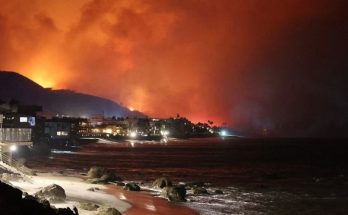As firefighters strive to contain the blaze threatening to consume homes in Malibu, California, other wildfires burn in Texas, Pennsylvania, Massachusetts, and Virginia.
Forest fires are natural phenomena, yet studies show they are becoming more widespread, consuming larger areas of forest each year.
“Natural ignitions occur as a result of lightning strikes in the growing season,” said Virginia Tech fire ecology and management expert Adam Coates. “Fire is part of Earth’s natural landscape. It has been part of the ecosystem for millennia. In fact, we now know that indigenous peoples utilized fire for a variety of purposes, even burning in the dormant season.”
Factors causing unnaturally high numbers of forest fires
“In the 2020s, many factors have contributed to create an environment in which forested lands are inundated with a lot of dense vegetation that, under ideal circumstances, would have been managed and removed, thus supplying a lot of material that can catch on fire,” Coates said.
“Even forests that were once intentionally planted in the 1920s to reclaim abandoned agricultural lands, for example, are often dense and in need of thinning,” he said. “Additionally, invasive species can and do play a large role in some wildland fires, contributing both to the total amount of fuel available to burn and in some cases altering the overall flammability of the vegetation.
“A lot of that vegetation is interconnected starting at the forest floor and stretching all the way to the canopies of the trees. We call that a ‘ladder effect’ for fuels—we have basically allowed a vertical structure to be built that once a fire starts on the ground it can very easily and very quickly escalate to the tops of the trees.
“Coupled with longer periods of time that are hotter and drier, we have all of this vegetation rapidly drying out, increasing the probability of ignition. Once those materials ignite, they often create large wildfires that are difficult to suppress,” Coates said.
“High winds, dry fuels, and low relative humidity are a recipe for extreme fire behavior, particularly in steep or rugged terrain. Wildfires in grasslands and shrublands can be hard to contain, also, because those fuels often produce large flames and spread rapidly with just minor fluctuations in wind speed and direction.
“In the United States, most large wildfires have occurred during times that are really dry. Many of the ignitions have also been aided by winds that have amplified the burning conditions,” he said. “Though we often think of wildfires as a problem in the western U.S., more and more ignitions are occurring in other locations. Currently there is a large fire in Malibu, California, but we’ve seen large fires in Canada, New Jersey, New York, and even Virginia over the last several years.”
Using fire to prevent fires
“The controlled application of fire by a team of fire experts, or prescribed fire, makes for one of the most powerful tools we have available to reduce hazardous wildfire ignitions, not only by reducing hazardous fuel loads, but also altering fuel structure in ways that minimize the possibility of fires starting on the forest floor and spreading to the canopies of trees, creating crown fires. Many threatened and endangered plants and animals benefit from landscapes that are frequently burned with low intensity and low severity prescribed fires,” Coates said.
Tips for homeowners
“Individuals should be cautious when selecting and maintaining vegetation around their homes. They should also be aware of the entrances and exits of their neighborhoods because it is potentially problematic for roads to be narrow with only one way in and one way out. Individuals should also be aware of conditions that may be noted by Red Flag Warnings where outdoor burning of any kind is prohibited,” Coates said.
“Excellent materials for individual homeowners and homeowners’ associations can be found online at Fire Adapted Communities, Firewise USA and the Virginia Department of Forestry’s Daily Fire Danger Rating page.”
Provided by Virginia Tech





